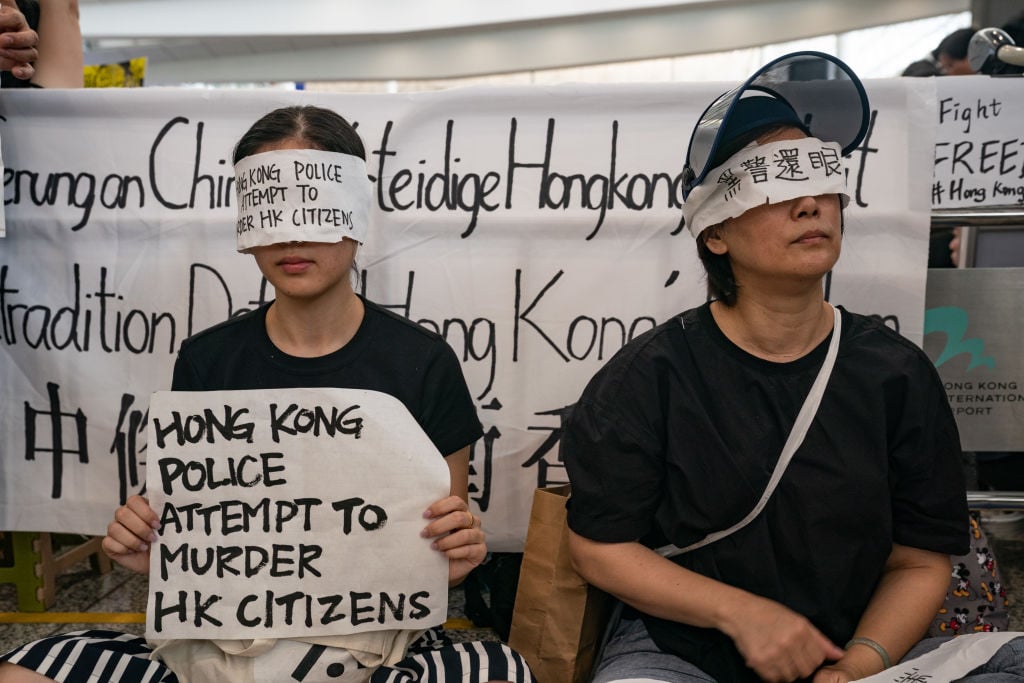
Artists joined demonstrators occupying the Hong Kong International Airport over the weekend to create protest art in its arrival hall, transforming the airport into a makeshift art studio. Since the sit-in began on Friday, hundreds of protesters have swelled to thousands, causing the airport, which is one of the world’s busiest, to cancel all flights departing today, August 12.
Since the protests began on June 9, artists have been wondering about their role, and many have taken up the job of disseminating information to the wider public. At the airport, artists-turned-activists have been creating paintings, illustrations, and graphics to publicize the reasons for their protest. Travelers were greeted by protesters chanting “Free Hong Kong!” and were handed educational materials about the reason for the territory’s continuing civil unrest, which is entering its tenth week.
Protesters have also been translating leaflets into different languages, including English, Chinese, Korean, and Japanese. In keeping with the democratic nature of the protests, anyone can contribute their protest art to the cause, and all are encouraged to share it on social media, including Instagram, Telegram, Airdrop, and LIHKG.
Protest art at the airport ranged from posters and stickers to pamphlets and informational videos documenting the increasingly violent response to street demonstrations by the Hong Kong police officers, who have used teargas and “non-lethal” ammunition to disperse gatherings. Earlier today, some people began leaving the airport terminal as rumors circulated that the police intend to move on protesters, the BBC reports.
Protesters stick memo notes on a “Human Lennon Wall” at the arrival hall of the Hong Kong International Airport during a demonstration on August 11, 2019 in Hong Kong, China. Photo by Anthony Kwan, Getty Images.
Ai Weiwei is the most high-profile Chinese artist supporting the demonstrators. While he is based in Europe, he was quick to send members of his studio to Hong Kong to document the protests. Ai’s researchers have been recording dramatic footage, which he says he will use to produce either an artwork or a documentary. In the meantime, he has been posting videos, including protesters being teargassed from the roof of a high-rise building, on his Instagram.
“We are really on the front line; we are fighting for human rights, for freedom of speech, and we are fighting for all the values we care about [alongside] those people who also care about those same values,” Ai told the BBC in a radio interview on Friday. He expressed concern about the escalating response to the protests and fears that the Chinese military will soon intervene, risking a repeat of the 1989 massacre at Tiananmen Square.
Although some of the protesters have focused on campaigning for foreign governments to intervene, the artist says he doesn’t expect the West to challenge China. He said that countries, including Britain, want to preserve “business as usual” with the world’s second largest economy.
While tension between the US and China is growing, US President Donald Trump recently echoed the rhetoric of the Chinese government by calling the protests “riots” and saying that the issue was between Hong Kong and China. Trump added: “They’ll have to deal with that themselves. They don’t need advice.” As for the UK, Ai said the Chinese government is “laughing” at the country’s inability to deal with Brexit negotiations. “It cannot even deal with its own issues that it is facing, I don’t think Britain will take any responsibility,” Ai said.
This weekend’s airport sit-in follows an earlier one on July 26, during which flight attendants and airport workers joined in. The anti-government protests kicked off on June 9, when more than one million people marched against a proposed bill that would allow people to be extradited to China to face trial. The bill has since been shelved, but not withdrawn, by the territory’s embattled chief executive. The protests have escalated to include wider concerns at China’s reduction of civil liberties in the semi-autonomous region, which has been run under the “one country, two systems” policy ever since it ceased being a British colony in 1997.